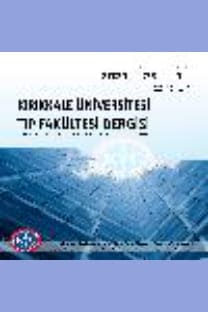İNME, SPİNAL KORD YARALANMASI VE SEREBRAL PALSİ HASTALARINDA ALT EKSTREMİTE ORTEZ KULLANIMINI ETKİLEYEN NEDENLER
Ortez, Ortez kullanma durumu, Rehabilitasyon
Factors Affecting Lower Extremity Orthotic Use in Stroke, Spinal Cord Injury and Cerebral Palsy Patients
Orthotics, Orthotic use, rehabilitation,
___
- 1. Taylor L, Yoo S. Orthotics. In: Maitin IB and Ernesto Cruz, eds. Current Diagnosis & Treatment: Physical Medicine & Rehabilitation. 1st ed. New York. McGraw-Hill Education, 2015:460-71.
- 2. Swinnen E, Lafosse C, Van Nieuwenhoven J, Ilsbroukx S, Beckwée D, Kerckhofs E. Neurological patients and their lower limb orthotics: An observational pilot study about acceptance and satisfaction. Prosthet Orthot Int. 2017;41(1):41-50.
- 3. Holden MK, Kathlee MG, Magliozzi MR, Nathan J, Piehl-Baker L. Clinical gait assesment in the neurologically impaired: Rehability and meaningfulness. Phys Ther. 1984;64(1):35-40.
- 4. Brunnstrom S. Motor testing procedures in hemiplegia: based on sequential recovery stages. Phys Ther. 1966;46(4):357-75.
- 5. Erhan B, Gündüz B. Omurilik Yaralanmalarında Klinik Muayene, Sınıflama ve Fonksiyonel Değerlendirme. Türkiye Klinikleri Beyin Cerrahisi Özel Sayısı. 2015;5(2):43-50.
- 6. Winter BA, Cordelia R, Perales FP. Reliability and validity of the gross motor function classification system for cerebral palsy. Pediatr Phys Ther. 2003;15(4):247-52.
- 7. Aybay C. Spastisite-Yetişkin Hastaya Yaklaşım: Klinik, Elektrofizyolojik ve Biyomekanik Değerlendirme. Türkiye Fiziksel Tip ve Rehabilitasyon Dergisi. 2007;53 (8):45-52.
- 8. Alemdaroglu E, Mandiroglu S, Ucan H, Celik C. The continuity of orthosis use by paraplegics which had been prescribed during in patient rehabilitation. Turkish Journal of Physical Medicine & Rehabilitation. 2014;60(3):223-30.
- 9. Onat Ş, Erkin G, Özel S. Genç ve Yaşlı İnmeli Hastalarda Ortez Tercihleri. Fiziksel Tıp ve Rehabilitasyon Bilimleri Dergisi. 2014;17(2):73-8.
- 10. Dilek B, Gur G, Yakut Y. An investigation of the duration of ankle foot orthosis’ daily usage in children with cerebral palsy: a pilot study. Journal of Exercise Therapy and Rehabilitation. 2015;2(2):47-52.
- 11. McMonagle C, Rasmussen S, Elliott MA, Dixon D. Use of the ICF to investigate impairment, activity limitation and participation restriction in people using ankle-foot orthoses to manage mobility disabilities. Disabil Rehabil. 2016;38(6):605-12.
- 12. Safaz I, Turk H, Yasar E, Alaca R, Tok F, Tugcu I. Use and abandonment rates of assistive devices/orthoses in patients with stroke. Gulhane Med J. 2015;57(2):142-4.
- 13. Nakipoglu-Yuzer GF, Koyuncu E, Cam P, Ozgirgin N. The regularity of orthosis use and the reasons for disuse in stroke patients. Int J Rehabil Res. 2018;41(3):270-5.
- 14. Magnusson L, Ahlström G. Patients’ satisfaction with lower-limb prosthetic and orthotic devices and service delivery in Sierra Leone and Malawi. BMC Health Serv Res. 2017;17(1):102.
- ISSN: 2148-9645
- Yayın Aralığı: 3
- Başlangıç: 1999
- Yayıncı: KIRIKKALE ÜNİVERSİTESİ KÜTÜPHANE VE DOKÜMANTASYON BAŞKANLIĞI
Halil ÇETİNKAYA, Yücel YÜZBAŞIOĞLU, Mehmet Akif KARAMERCAN, Yavuz KATIRCI, Meral TANDOĞAN, Figen COŞKUN
Ahmet Sinan SARI, Ubeydullah SEVGİLİ, Özgün KARAKUŞ
DİZ OSTEOARTRİTİ TEDAVİSİNDE KOMBİNE FİZİK TEDAVİ VE KAPLICA TEDAVİSİNİN ETKİNLİĞİ
Şahika Burcu KARACA, Nursel DOĞANYİĞİT KUZAN
Safra Taşı İleusu Değerlendirmesinde Radyolojik Görüntülemenin Klinik Faydası
Adnan ÖZDEMİR, Yunus YILMAZSOY, Serdar ARSLAN, Faruk PEHLİVANLI
İdiyopatik Karpal Tünel Sendromlu Hastalarda Tedavi Öncesi ve Sonrası MRG Bulguları
Şahika Burcu KARACA, Rula ŞAHİN, Leman GÜNBEY KARABEKMEZ, Tevfik YETİŞ, Nihal DURAN
Ahmet Sinan SARI, Ubeydullah SEVGİLİ, Özgün KARAKUŞ
Hasanali DURMAZ, Bülent ÖCAL, Erdem BİRGİ, Onur ERGUN, Kemal KESEROGLU, Emel ÇADALLI TATAR, BAKİ HEKİMOĞLU, Mehmet Hakan KORKMAZ
TİROİD İNCE İĞNE ASPİRASYON BİYOPSİLERİ İLE HİSTOPATOLOJİ SONUÇLARININ KARŞILAŞTIRILMASI
DÜŞÜK VE YÜKSEK OVER REZERVLİ VAKALARDA VEGF POLİMORFİZM SIKLIĞININ KIYASLANMASI
